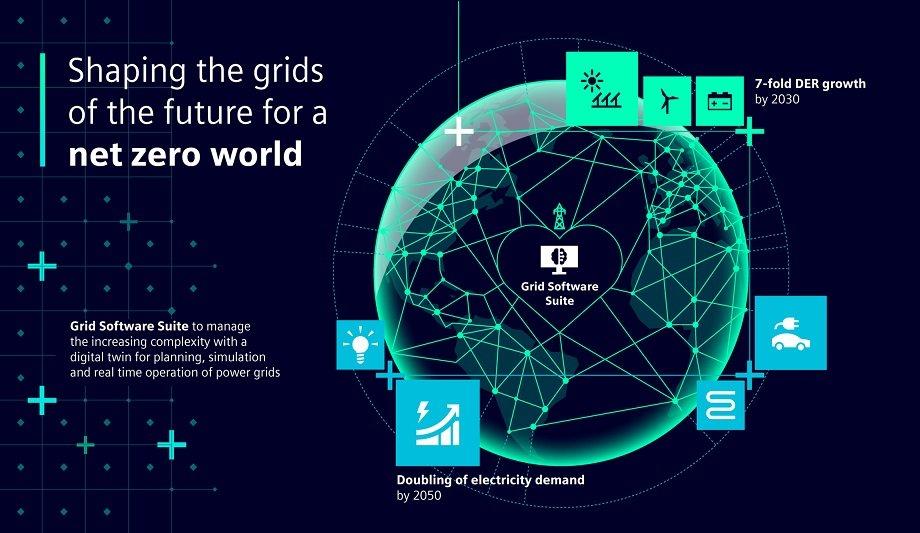In an industry first, Siemens Smart Infrastructure announced an open, modular suite of grid software to address the increasingly critical energy transition.
The suite is a game-changer for established energy players and new stakeholders alike, enabling them to be fast, agile, and flexible when coping with existing and future challenges.
85% improved task efficiency
Siemens has already made significant steps to improve its offering for smart meter data management such as a cloud-native option or improved task efficiency by up to 85 percent by redefining the user experience.
Siemens’ software also enables customers to run grid protection simulations up to six times faster than the current speed of execution, supporting utilities to better plan, operate, and maintain power networks.
Real-time operations and maintenance
The speed and scale of changes in the energy system are unprecedented, as DERs grow exponentially"
All upcoming modules of the software suite from Siemens will be developed following specific design principles to interact seamlessly and enable agility. At the same time, they will keep the power grid cyber resilient while also creating a digital twin of the grid throughout the planning, simulation, real-time operations, and maintenance of power grids.
“The speed and scale of changes in the energy system are unprecedented, as distributed energy resources grow exponentially,” said Sabine Erlinghagen, CEO of Grid Software at Siemens Smart Infrastructure.
Power grids
“Power grids are at the heart of a sustainable energy system and are becoming increasingly more complex. We cannot manage this complexity without open, modular, and interoperable software.”
“By introducing the most comprehensive software suite in the market to date, we are leading the change to shape the grids of the future to a 100 percent renewable world. We are aware we cannot achieve the energy transition alone – we work with customers and partners.”
A co-innovation approach with partners
Siemens also announced that it is collaborating with leading players in the industry to rethink grid management jointly.
Working together in a co-innovation approach, the partners seek to find ways to seamlessly plan, operate, maintain and optimize power grids. Working closely with customers that use Siemens’ software will support faster adoption and integration.
Partner network
Siemens is open to complementary product partners aspiring to jointly innovate in the grid software space
To date, partners include companies such as CESC Limited (India), CMY Solutions (USA), Elvia (Norway), Hawaiian Electric (USA), IRETI (Italy), KNG-Kärnten Netz GmbH (Austria), Quanta Technology (USA), Stadtwerke Flensburg (Germany) and Statnett (Norway).
Siemens is also open to complementary product partners aspiring to jointly innovate in the grid software space and will foster its partner network to support customers’ workflows end-to-end.
The urgency to digitalize
A look at the energy landscape explains the urgent need to bring intelligence to a vast and complex system that forms the backbone of economies. Worldwide, electricity consumption is forecast to double by 2050.
Through 2030, Guidehouse Insights forecast a seven-fold growth in new distributed energy resources (DERs) annually with fluctuating infeed and demand.
Low voltage level
In 2020, five million assets were introduced to the supply and demand side. The DERs are connected to the power grid mostly on the low voltage level where grid operators to date have not achieved much transparency.
Due to the intermittent nature of the DERs, it is much harder for grid operators to control the power grid and predict what will happen next.
Autonomous Grid Operations
We need disruptive and fast change where investment in software comes first and helps us leapfrog to green energy"
Erlinghagen adds, “Traditional investment in hardware alone is not sufficient to deal with the complexity we see in energy systems today. We need disruptive and fast change where investment in software comes first and helps us leapfrog to green energy, away from reliance on fossil fuels.”
“We’ve started this journey to transform our portfolio and plan to speed up towards our vision of autonomous grid operations.”
Growth in grid software
Experts expect a doubling of the market volume for grid software from USD 8 billion in 2019 to roughly USD 17 billion in 2028. During Capital Market Day in 2021, Siemens Smart Infrastructure committed to doubling its digital revenue to EUR 1.5 billion by the fiscal year 2025 from EUR 750 million in fiscal 2021.
Siemens is already a pioneering company for software for power grids. About 70 percent of the world’s electricity consumption or 16,000 terawatt-hours each year already flows through infrastructure simulated by Siemens’ grid software.
EnergyIP
Today, 1,300 control center systems that operate and control grids based on Siemens’ software are in operation worldwide, keeping the lights on for hundreds of millions of people.
With approximately 100 million contracted smart meters, in use by over 200 utilities globally, the meter data management software EnergyIP is a rich source of data at the low-voltage grid level.
Modular, seamless offering
Through the modular approach, the parts will fit together and can be tailored to meet the individual needs
The new grid software offering enables energy companies to easily and quickly implement smart technology for their grid planning and management. These IT upgrades will be faster and less costly than investments in hardware. of grid operators.
With seamless integration of IT and OT elements, due to one unified network model, customers can synchronize data easily across their IT and OT systems, including their grid planning software, meter data management systems, Geographical Information Systems (GIS), and Advanced Distribution Management Systems (ADMS), and then optimize workflows end to end.
Improved grid operations
Insights from analytics and AI will be directly transferred into actions, which lead to a significant improvement in grid operations. This allows a shift from a deterministic to a probabilistic management approach, fostering the integration of a large number of distributed energy resources.
Additionally, across its power grid portfolio, Siemens meets strict cyber security requirements, security standards, and regular security updates.
